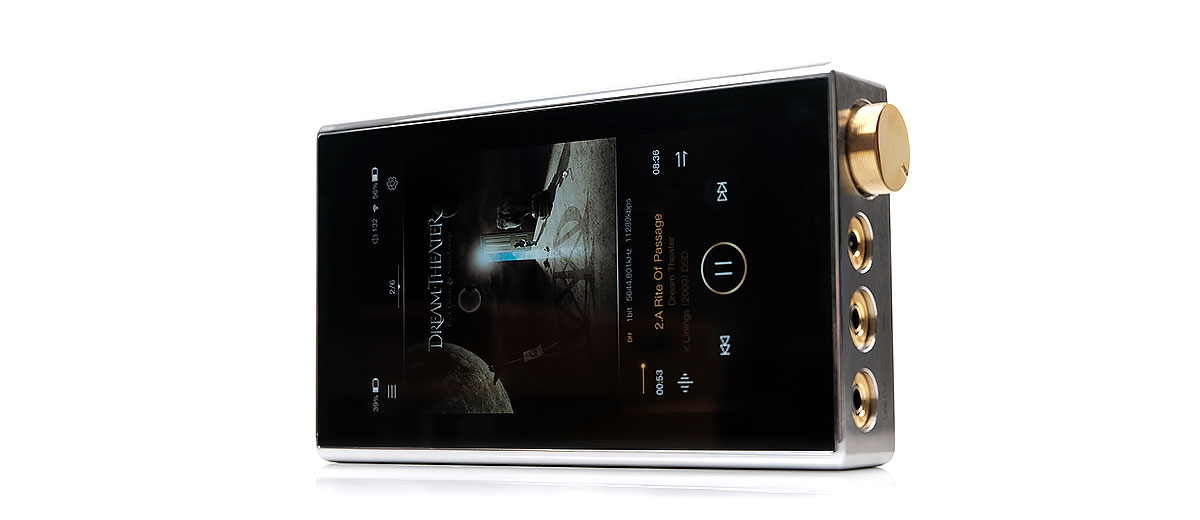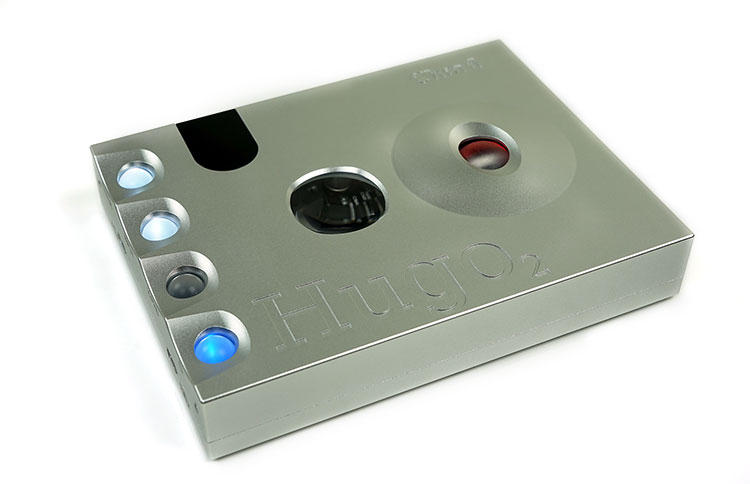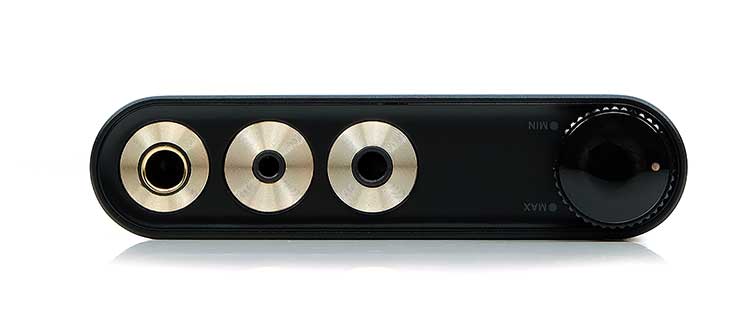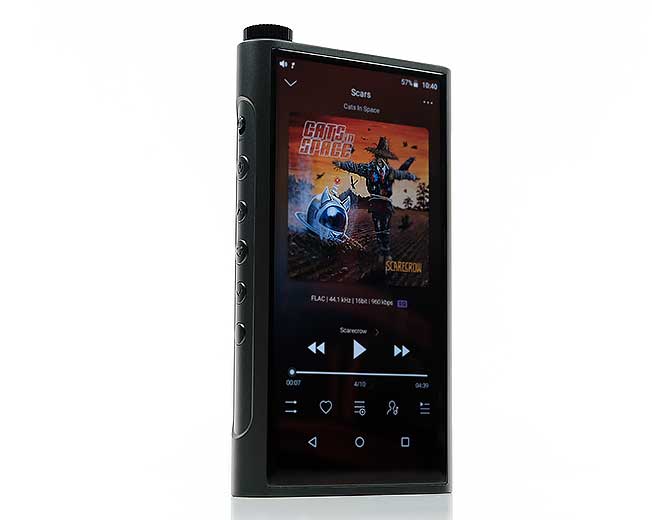Select Comparisons
iBasso DX220
$899
Digital Technical
For me, the DX220 MAX is the DX220 with a reworked analog stage and power supply. However, that is still a pretty significant change. With the digital and analog side split though you can see easily where the differences and similarities are.
On the DAC or digital side, you get pretty much all the similarities. That means both have a dual ES9028PRO chipset implementation and an excellent 5-piece Femtosecond League Oscillator design, 2 of which are Accusilicon Ultra Low Phase Noise Femtosecond Oscillators.
The two players can decode to the same PCM 32BIT/384kHZ and DSD512 level using a USB-C XMOS USB receiver with a Thesycon USB driver. Both are also MQA X4 mode capable of native unfolding and both have BT5.0 with LDAC as well as WiFi 5G support.
Both have Android 8.1 Oreo, they operate in virtually the same manner with access to Google Play via APK Pure. They also both dual boot into Mango OS and only very nuanced differences there such as no physical button option since the DX220 MAX has no physical buttons other than to power it on.
The only key difference is the power supply which is dedicated to the DX220 MAX digital setup and shared on the DX220 with its analog output.
Analog Technical
A massive difference here. The DX220 uses the legacy amp card system so you get a lot more different flavors with up to 9 different cards including the tube-flavored AMP9.
The DX220 MAX is a fixed amplification stage but with a dedicated high voltage battery power supply (DC in only not USB-C) and a mix of 3.5mm and 4.4mm PO and LO. None of the iBasso amp cards have that same combination at the time of writing. Many of them opt for 2.5mm TRRS/3.5mm combos or a single 4.4mm PO like the AMP8.
The maximum Vrms output on the DX220 MAX compared to the AMP cards is higher by up to 25% on AMP1 MKII and similar for the AMP8. You get more power as well as cleaner power from the DX220 MAX which is better suited to driver high-impedance headphones.
Design
Well, no question the 240g DX220 is the more portable device. It is a pure DAP for me whereas the 700g DX220 MAX is baggable but most of the time it is on a desk compared to your hand.
Do not expect to find any physical buttons except the power/screen on/off the DX220 MAX whereas the DX220 does have 3.
For such a size changeup they both use the same 5″ IPS screen though the DX220 MAX is locked at 1080p and the DX220 can switch from 1080p to 720p to maximize performance.
The pop is better on the borderless design of the DX220 bezel but actually, I found the swiping easier on the thicker bezel of the DX220 MAX with the cases on each.
Much prefer the superior analog potentiometer of the DX220 MAX to the rotary dial of the DX220. It is more accurate and far easier to access. The DX220 dial is very tight to the body and difficult to use with the soft case often getting in the way.
Battery life on the DX220 varies with the AMP card selected but with AMP1 MKII it is average at 8-10 hours. You can do better with the 720p option. The DX220 MAX actually has a much better battery life at 14 hours for the digital side and around 15 hours for the Analog. Both have fast charging capability.
Finally, though both use single-slot microSD card slots, the DX220 MAX has better onboard storage at 128GB compared to 64GB on the DX220.
Performance
In terms of the noise floor, the DX222 MAX is lower compared to the DX220 with AMP1 MKII (stock) for both balanced and unbalanced using our most sensitive IEM, the Empire Ears Zeus. Both will display a minor amount of hiss with this monitor but it is noticeable how much lower the MAX is.
Our next most sensitive, the Campfire Audio Solaris 2020 did not show much hiss on either unbalanced outputs of the two players but we did pick up more hiss going unbalanced on the DX220 2.5mm TRRS compared to the 4.4mm balanced of the DX220 MAX.
Testing with a Dan Clark Audio Ether 2, no doubt there is more headroom on the DX220 MAX balanced with more available current (depending on the digital volume level setting) compared to the DX220 AMP1 MKII. Dynamic range is also better with improved instrumental separation and clearer vocal performances, (more air around the vocal notes).
Tuning
Both deliver that classic iBasso reference house sound with an emphasis on neutrality and a large soundstage element. However, you can tell right away that the DX220 MAX analog amp has a better level of dynamic range.
It is the type of gap that has you reaching for the DX220 volume constantly because you think there is a slight mismatch but no matter how moderately high you go it still sounds a shade muted compared to the DX220 MAX.
When I say muted I mean for example the punch of a drum hit, the rise and fall from loud to soft of that note. It is just the more vivid of the two on the DX220 MAX. Using both the Zeus and Solaris 2020 conveyed that vividness from the MAX in more convincing terms. The DX220 tended to sound softer, with less nuanced detail and with a little more bass bloom on the low end.
With the 2 monitors, the mids performance on the DX220 MAX was also more refined. Again, the DX220 had a little bit of lower-mid softness whereas the DX220 MAX pairing sounded more precise with better imaging and a little richer as well as more resolving in the vocal delivery.
I suspect that is due to the harmonic balance overall as the DX220 treble felt a shade more brittle and harder-edged compared to the DX220 MAX performance.
The MAX treble is as airy but smoother and with a bit more texture. It leaves vocals more on the natural side with less of a sibilant overtone, especially with the Zeus, which sounded smoother on the upper mids with the DX220 MAX pairing.
Chord Electronics Hugo 2
£1,800
Although the Hugo 2 is an Amp/DAC as opposed to a DAP or transportable media player it does share a similar function in terms of being a transportable DAC and amp. Its £1,800 price is not too far off the DX220 MAX marker either so it might be a potential alternative for desktop decoders.
Feature Differences
There are a few key differences between these two. The first few are rather obvious such as the lack of GUI, OS, onboard memory for media management, and WiFi on the Hugo 2. The recent launch of the 2Go module does some way to address the Hugo 2’s connectivity experience with WiFi now possible but it will cost you a bit more.
More than that the Chord UI can be tricky to understand with the orb color system and not entirely intuitive without reading the manual a few times. Android, well, enough said, most everyone understands apps and widgets.
Because the positioning is more of a traditional desktop connectivity focus, the Hugo 2 uses dual RCA outputs for connecting with analog amps.
The DX220 MAX does have a LO, however, and it is a balanced LO. Chord has shied away from balanced, only offering 6.35mm and 3.5mm TRS outputs to the rear whereas the DX220 MAX offers that 4.4mm balanced LO/PO option at the front.
Both have Bluetooth, however, the Chord implementation is more of a ‘useful to have’ than anything complex with BT4.2 and aptX protocols only whereas the DX220 MAX is BT5.0 capable with LDAC decoding and bi-directional.
You can link the two of them if you wish but I do not recommend BT from the Hugo 2 for audio quality.
DAC
This is where the Hugo 2 stands out for me with its Xilinx Artix 7 chipset and an enhanced Watts Transient Aligned filters (WTA) tap-length of 49,152 using a 10-element Pulse Array design.
The delta-sigma ES9028PRO of the DX220 MAX is very good and its implementation with digital power isolation means it will outperform a lot of similar class delta-sigma DACs. However, its tap length is measured in the 100s and on a technical level has a lot more limitations.
On paper, however, they can both decode DSD natively to a similar level of DSD512 but for PCM, the Hugo 2 moves ahead with 768kHz/32-bit compared to 384kHz/32-bit on the DSD220 MAX.
The Hugo 2 is not compatible with MQA and is not likely to be given Rob Watts’s disdain for MQA’s performance. If you are an MQA fan the DX220 MQA 4X mode is the way to go.
Amplifier
This is where I believe the DX220 MAX has a bit of an advantage in terms of power. I cannot pass comment on the individual components used to design the Hugo 2 signal path compared to the materials listed for the DX220 MAX. They are simply not listed by Chord.
We do know the Hugo 2 is a Class A single-stage amp coupled via individual resistors and does not use any opamps. Its amp volume resides entirely in the digital domain whereas the DX220 MAX amp is pure analog.
We can compare numbers all on a broad level, and here the DX220 MAX amp stage performs rather well. The Hugo 2 does have an excellent 740mW into a 32Ω load unbalanced output rating.
As a rough translation, the 4.35Vrms 300Ω load of the DX220 MAX unbalanced output comes out slightly weaker at 590mW into 32Ω.
However, at 8.7Vrms balanced, the DX220 MAX does exceed 740mW into 32Ω. We have to be careful not to assume that the calculated conversion of 2.365W into 32Ω because iBasso does not use the usual formula for their power ratings.
However, confirming with iBasso the D220 MAX does output more power balanced than the Hugo 2 maximum unbalanced levels at 1.7W into 32Ω balanced.
The quality of their analog signals is also very competitive. The maximum SNR of the Hugo 2 is 125dB compared to the 122dB unbalanced output of the DX220 MAX. However, for balanced, the DX220 MAX is on par at 125dB.
Performance
In terms of real-world testing, the DX220 MAX amp has a blacker background and is quieter with sensitive IEMs from the Zeus to the Andromeda and Campfire Audio’s Solaris SE. The Hugo2 will exhibit more background hiss with these IEMs.
Since the Hugo 2 works purely on a single-ended output we cannot make a direct balanced output comparison for noise with these IEMs. However, the balanced output of the DX220 MAX is quieter than the single-ended output of the Hugo 2 when tested with sensitive monitors. I would avoid monitors of this type with the Hugo 2.
Neither have issues driving our test headphones, the Dan Clark Audio Ether 2. Both have plenty of current on-demand and the dynamic range on both is excellent.
The one thing to note is going balanced on the DX220 MAX is preferable and you do need a higher digital volume setting of around 140+ to give yourself some useable analog volume control.
Tuning
Both are aiming for very similar territory with a reference-type sound that has a slight bias to natural rather than analytical and neither is overly peaky or sterile sounding. However, you will find differences on a more nuanced level and a technical level.
For a start, the DX220 MAX has a bit more body on the low-end, a shade more bloom into the mid-bass whereas the more linear Hugo 2 bass is a little tighter and quicker. The detail in the Solaris 2020 bass texture was also a little higher on the Hugo 2 sounding more 3-dimensional.
The mids on the DX220 MAX are sweeter, fuller sounding for me with a vocal that is slightly further forward or with more presence. The Hugo 2 remains relatively neutral in vocal as well as instrumental positioning so there is less focus on vocal delivery.
However, the instrumental separation is excellent on the Hugo 2 with just a tiny bit of body taken off in comparison to the DX220 MAX presentation. The imaging is very accurate and reference-like on the Hugo 2 whereas the DX220 MAX has a bit more forward emphasis on the mids and upper mids and a little more treble emphasis with the Solaris 2020 pairing.
You do hear a shade more natural sibilance on the DX220 MAX compared to Hugo’s vocal and percussion timbre but the treble forwardness is not huge on either. Rather the more forward vocal presence on the DX220 MAX picks up a bit more odd-harmonic influence from its treble than the neutral mids of the Hugo 2.
FiiO M15
$1299
The M15 is the cheaper of the two by some distance but I felt this was a useful comparison since the M15 is fresh on the market with plenty of useful features and a super-fast UI experience.
The key takeaway from the technical side is a single power/circuit integration inside the M15, much like the DX220. It does not have a separate analog circuit design or a separate power supply for the DAC and amp stages.
However, that does mean the M15 is much smaller and more transportable and is more of a modern DAP in that sense than the bigger or transportable DX220 MAX.
DAC
On the DAC side, both have dual-chipset implementations, however, the M15 uses a TOTL AKM AK4499EQ compared to the DX220 MAX’s ES9028Pro. Decoding between these two is very competitive indeed.
Both have DSD512 native decoding with XMOS USB chipsets. However, for PCM the M15 goes a step higher with 768kHz/32bit PCM decoding compared to 384kHz/32bit on the DX220 MAX.
The same is true for MQA which both can natively unfold. The M15 can go 8X unfolding compared to 4X from the DX220 MAX. Bitperfect decoding is available on both platforms with the M15 getting a recent firmware update to bring it outside of their app to the entire OS.
Both have Femtosecond oscillator systems. However, the dual setup of the M15 system is dwarfed by the 5-piece Femtosecond League Oscillator design of the DX220 MAX which can handle very high sample rates and is equivalent to a desktop DAC in many respects.
Amp
Here is where the DX220 MAX powers ahead for me. Granted, as a pure DAP, the M15 is probably the most powerful in its range at 800mW balanced under a 32Ω load but not even close to the 1.758W output capability of the DX220 MAX (7.5Vrms) on the same load.
At 300Ω the M15 is still very impressive at 280mW using its over-ear headphone mode. That is a little higher than the DX220 MAX’s calculated 235mW into 300Ω balanced capability.
However, the isolated analog architecture of the DX220 MAX delivers a signal with a bit more purity and a blacker background. It has a 3dB advantage for SNR balanced over the M15 at 125dB compared to 122dB and better THD+N performances at 0.00021% compared to 0.0006% balanced on the M15 using a 300Ω weighting.
In terms of I/O, the amp stage of the DX220 MAX lacks the M15 2.5mm TRRS but it does offer a 4.4mm balanced LO whereas the M15 only offers a 3.5mm unbalanced LO. Both offer 4.4mm and 3.5mm TRS PO.
Design
In terms of design, well it is kind of obvious. The M15 is no shrinking violet at 302g and is one of the bigger DAPs out there but it pales in comparison to the 700g DX220 MAX desktop form factor. The tall M15 can be handheld with physical button controls whereas the DX220 MAX needs to sit on a solid surface as it gets tiring to hold in your hand quickly.
Both have an analog potentiometer volume knob but the volume control on the M16 is not as good as the DX220 MAX. I find the FiiO implementation way too aggressive though I do appreciate the interface with the OS to see how the volume level is.
The M15 screen is taller at 5.15″ compared to the 5″ IPS panel of the DX220 MAX but its resolution is not as high at 720p compared to 1080p.
Features
The two players both have WiFi 5G capability, BT5.0 with LDAC decoding, and bi-directional support. Both use Android, however, the M15 is Android 7 compared to the DX220 MAX’s fresher Oreo 8.1. I believe that is more of a limitation of the Samsung processor inside the M15.
That being said, even with the 4GB of RAM, the older Rockchip inside the DX220 MAX performs nowhere near as fast as the M15’s Samsung CPU which is the fastest we ever tested, almost double the AnTuTu score of the iBasso player.
Neither ship with Google Play, instead you get APK Pure. However, both platforms will let you install the Google Play APK from the Pure app and will work just fine moving forward.
Onboard storage is better on the DX220 MAX at 128Gb compared to the M15’s 64GB and both have a single expandable microSD memory slot.
Both have good battery life performances with the M15 at 15 hours the DX220 MAX digital side at 14 hours and the analog amp at a similar 15-hour level. The two players also offer quick charging support including PD2.0.
Performance
Reverting again to our sensitive monitors, the Zeus and Solaris SE, both delivered a black background on the DX220 MAX compared to the M15 in both balanced and unbalanced mode. With unbalanced, the gap was not huge with a slightly higher hiss level from the M15 but otherwise a good performance.
However, from balanced output, the Zeus yielded a lot more hiss from the M15. The DX220 MAX background is not black either from the Zeus but it is a lot less pervasive. The Solaris SE had lower noise from both 4.4mm balanced outputs but the same pattern, lower on the DX220 MAX.
Both of these players can handle fairly demanding planars such as the Dan Clark Audio Ether 2, especially with FiiO over-ear headphone mode. I did not detect a huge dynamic range gap, though I would maybe give the DX220 MAX a slight edge in timbral matching which made it a more pleasing pairing with the Ether 2 compared to the M15.
Tuning
The M15 is cleaner and also a shade brighter, particularly through the upper mids and treble. The DX220 MAX exhibits a bit more warmth and power from the low end into the mids, a bit more instrumental body, and texture with a vocal positioning that is just a shade more neutral compared to the M15.
The M15’s brighter upper mids and treble tend to create a cleaner vocal, particularly higher pitching ones so they can be perceived as more energetic compared to the DX220 MAX. However, they are lighter in weight with a little less texture so not as planted-sounding.
This was particularly so with the Zeus pairing where we tested with Billie Eilish’s Bad Guy track. The DX220 MAX injected a bit more wetness and body into Billie’s vocals whereas the M15 was drier, more forward, and cleaner sounding.
It gave the impression that the M15 delivered a quicker pace with our paired monitors but took away a bit of texture in those vocals in exchange.
The DX222 MAX just has that sweet slightly fuller timbre with EE’s Zeus with a tiny bit less odd-harmonic presence that prevents any harshness creeping in. Not a lush or warm sound but rather the more natural of the two.
You can tell when upper mids and treble percussion comes in with the M15 delivering more of a digital tone to the notes and the DX220 MAX sounding more refined.
I would not say the M15 is splashy and sibilant, far from it. Rather it is just that the DX220 MAX harmonic balance has a bit more even-harmonic presence which gives percussion notes a bit more pleasing tone.
That better low-density and weight from the DX220 MAX plays a key role in delivering that pleasing even-harmonic element.
Our Verdict
No question the DX220 MAX is the most accomplished media player iBasso has ever made and puts the already impressive DX220 (AMP1 MKII) firmly in the shade in terms of sound quality.
The dual independent power supply and completely reworked analog amplification stage are immaculate and exemplify the iBasso house sound with just a smidgen more warmth to deliver a beautifully natural but still reference-type sound.
It has enough output adjustments and a low noise floor to work equally well with IEMs and headphones as well as that excellent PMEQ system that first showed up on the DX220.
However, this is not a DAP for me. I mean you can use it as a DAP but the size is difficult to get around for day-to-day portable use.
The use of the dual battery configuration, multiple battery charging, and switching back and forth for digital volume control does not make it a handy go-to portable device. This is desktop level, but a highly transportable desktop player at that.
Only 999 units of this are available apparently so it is a limited edition in a way and that is a shame because it positioning and performance demand a lot more exposure than 1 shy of 1000 people. If ever we get trade shows back again I highly recommend you give the DX220 MAX a demo because it is quite the experience.
iBasso DX220 MAX Specifications
- Operating System: Android 8.0
- CPU: 8 Core
- RAM: 4GB LPDDR3
- ROM: 128 GB (118 GB free space / approx 10GB are reserved for the OS)
- Screen: 5.0” 1920*1020 (1080P) IPS Screen
- DAC: Dual ES9028Pro DAC Chip
- Decoding formats: MQA, APE, FLAC, WAV, WMA, AAC, ALAC, AIFF, OGG, MP3, DSF, DFF, DXD, CUE, ISO
- Decoding rates: PCM: 8kHz – 384kHz (8/16/24/32Bit)
- Native DSD: DSD64/128/256/512
- Analog Outputs: 4.4mm Line Out, 3.5mm Phone Out, 4.4mm Balanced Out (TRRRS)
- Digital Out: SPDIF/Coaxial, Mini Optical Out, USB Type-C
- XMOS Receiver: XMOS USB Receiver for Native DSD Support (up to 512x)
- Battery Digital Par: 1 x 4400mAh 3.8V Li-Polymer
- Battery Analog Part: 4 x 900mAh (3600mAh) 8.4V Li-Polymer
- Battery Life: Average playtime 14 hours, 2.5 hours charging time amp, 2 hours DAC
- Size: L145MM x W86MM x H27MM
- Weight: approx 700 grams (1.55 pounds)
3.5mm Single Ended Output (TRS)
- Output Level (No Load): 4.40VRMS (-105.5dB, 0.00053%)
- Output Level (@300ohm): 4.35VRMS (-104dB, 0.00063%)
- Frequency Response: 10HZ-40KHZ+/-0.2dB
- SNR: 122dB
- Dynamic Range: -122dB
- THD+N (no load, DAC140): -114dB (0.0002%) (2.5VRMS)
- THD+N (@300ohm): -112dB (0.00025%) (2.5VRMS)
- THD+N (@32ohm): -97dB (0.0014%) (2.5VRMS)
- Crosstalk: -118dB
4.4 mm Balanced Output (TRRRS)
- Output Level (No Load): 8.8VRMS (-108dB, 0.0004%)
- Output Level (@300ohm): 8.7VRMS (-107dB, 0.00045%)
- Frequency Response: 10HZ-40KHZ (-0.2dB)
- S/N: 125dB
- Dynamic Range: -122dB
- THD+N (no load, DAC132): -114dB (0.0002%) (3VRMS)
- THD+N (@300ohm): -113.5dB (0.00021%) (3VRMS)
- THD+N (@32ohm): -101.5dB (0.00084%) (3VRMS)
- Crosstalk: -119dB
4.4mm Line Output
- Output Level (no load): 4.4VRMS (-112dB, 0.00025%)
- Frequency response: 10HZ-40KHZ (-0.2dB)
- SNR: 125dB
- Dynamic Range: -125.8dB
- THD+N (DAC141): -115.4dB (0.00017%) (2.6VRMS)
- Crosstalk: -115dB









